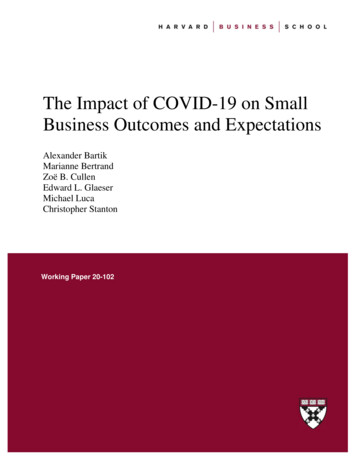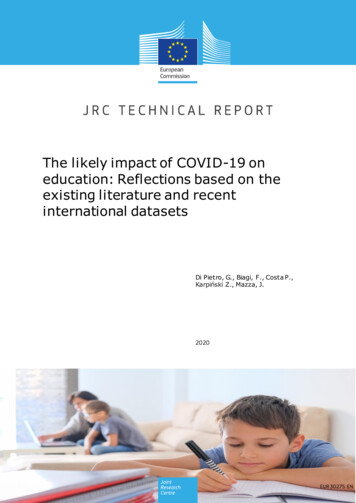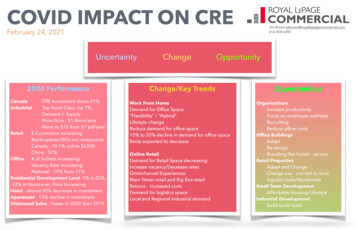
Transcription
Impact of the Covid-19 outbreakon Media & EntertainmentOverview of Key Industry Disruptions & Post-Crisis Challenges and OpportunitiesMay 26th, 2020
COVID-19 has had multipleimpacts on the Media& EntertainmentIndustryThe Coronavirus crisis has led certain M&E segments to a stronggrowth in consumption but with monetization challengesOthers are dealing with severe income loss & heading towardsstrong disruptions and a long term recovery cycle
EXECUTIVE SUMMARYWorldwide lockdowns lead to ashift in media consumptionSignificant revenue decline is likelyto linger on the back of a weak economyDelayed production promisescontent supply shortagesHighlights The ‘at-home-entertainment’ providers &trustworthy news outlets are engaging usersmore and finding new and larger audiences Gaming – category reporting the largest increasein consumption – is also expanding theexperiences it offers eSports are gaining legitimacy Revenue is down overall as the industry reliesheavily on advertising Entire segments of the industry are at a stop:Movie Theatres are shutdown, film producers anddistributors are struggling without the possibility ofa theatrical release, live music – main source ofrevenue for the music industry – is at a standstill,sports is losing income on all fronts Production is at a full stop at a time where peopleconsume more, putting pressure on contentlibraries and threatening shortages Though no one is spared, mitigating factors andcompensatory effects are emergingKey recommendationsCost cutting, improved operational efficiencyprograms and move to cloudOptimizing content library amortization andimproving content discoveryReducing lead times through automation &workflow orchestrationInvesting in the areas with the highest potential(OTT, Gaming, cross-play )Innovation to improve efficiency and find newrevenue streams (dynamic ad insertions, gamifiedsports viewership, interactive digital live musicexperiences )Scaling up efficiently through move-to-cloudGoing direct-to-consumer for a new revenue streamSeizing the opportunity that habit formation &sampling bring through digital growth (largerdigital presence, improved customerexperience )Building stronger content banks (productionprocesses automation, video & metadata sourcing)& rationalizing content production (using AI/ML)The information contained in this document is proprietary. Copyright 2020 Capgemini. All rights reserved.3
QUICK ACTION GUIDE12 priority actions to restart and reshape business and operationsWe can help you:ProductionRESTARTRelaunchingbusiness andoperationsOperationsLive EventsAdvertizing1Set-up restart & reshape COVID RESPONSE CONTROL ROOMS (customer-employees-suppliers)2Instill EFFECTIVE REMOTE WORKING37RESHAPEAdapting to thepost covid contextIndustry PositionDistributionReopen & restartproduction withSMART ENTLIBRARY & Goto-market8SUPPLY CHAINautomation toreduce lead time9Carry out a RETAIL RESTARTWITH ON/OFFLINEAccelerateDIRECT-TOCONSUMER10 DevelopNEWCONCEPTS11Develop POST-COVID CUSTOMER INSIGHTS12Build SUSTAINABILITY6OPTIMIZE &MODERNIZEADSALES businessthrough linear & digitalsales rationalization,optimized Adimpression, contextualtargetingThe information contained in this document is proprietary. Copyright 2020 Capgemini. All rights reserved.4
COVID-19 hasimpacted multipleareas of the industry1Worldwide lockdowns lead to a shift in mediaconsumptionSignificant revenue decline is likely to linger onthe back of a weak economyDelayed production promises content supplyshortagesThe information contained in this document is proprietary. Copyright 2020 Capgemini. All rights reserved.5
1. Worldwide lockdowns lead to a shift inmedia consumptionIncrease in at home entertainment & trustworthynews outlets consumptionThe pandemic generated:A positive customersentiment towardsprint mediaA surge in TVviewership especiallyfavorable to OTTA bolstering ofgaming’s growth andascendanceA gain in legitimacy &an acceleratedexpansion for eSportsTheTheinformationcontainedin thisdocumentis proprietary.Copyright 2020Capgemini.All Allrightsreserved.informationcontainedin thisdocumentis proprietary.Copyright 2020Capgemini.rightsreserved.66
In a time of doubt the public heads towardstrustworthy news outlets and their digital servicesPositive customersentiment towardsprint mediaTraffic to trusted digital media publishers has increased: News sites are reporting traffic increases that are anywherefrom x2 to x4 their normal levelsooooThe evidenceThe Atlantic, Business Insider, The New York Times, The Los Angeles Times, The Wall Street Journal and Wired have all “doubled ornearly doubled the number of visits” to their sites according to the New York TimesThe audience for Verizon Media sites, including HuffPost & Yahoo News, has increased by nearly 80% in MarchThe number of readers visiting Vox.com increased 60% from the first week of March to the secondThe number of unique visitors to Vanity Fair soared 44% the second week of marchTime spent on news sites has also surged: The number of minutes spent by readers at news sites increased 46%according to a study of more than a dozen general news websites by comScoreSome news sites even see a boost in subscriptions: though many publishers chose to allow free online access to Covid-19 News, temporarily taking down paywalls and article limits, some have been able to convince readers to support them bysubscribingooThe Atlantic (American magazine founded in 1857 turned multi-platform publisher) reported 36,000 new subscribers in March whennews sites in its peer group would have been thrilled with 36,000 subscribers full stopOn Sunday, March 15th there were 58% more new subscriptions to US news sites than on any other SundayPrint sales have fallen dramatically for national, regional and local newspaper and specialized press due to shutdownSeizing the opportunity generated by habit formation and positive customer sentiment:Challenges &opportunitiesahead Transforming readers into subscribers leveraging data to better understand new customers and find look-alike audiences Accelerating digital transition & growth Having a digital presence & building strong integrated digital products is critical Finding the right monetization model is key to transform this increase in consumption into an increase in revenue while advertisingrevenue is at an all time lowThe information contained in this document is proprietary. Copyright 2020 Capgemini. All rights reserved.7
TV & OTT services find new audiences and see theircurrent audience spend more time watchingSurge in TVviewership especiallyfavorable to OTTOverall increase of video & TV viewership: With peoplespending more time at home, there are more entertainment hoursto fill watching TVooOn average French viewers spent 44 additional minutes in frontof the TV in March ( 16%) according to MédiametrieIn the US Nielsen reports that overall TV viewing is up 20%US Direct to Consumer App Sign-Up volumes(indexed to 100 for pre-Covid sign-ups)Source: AntennaOTT services are getting the brunt of that growth:oThe evidenceoComcast reports linear TV viewership is up by 6-7% in the USand OTT video is up by 38%HBO claims consumption of HBO Now is up 40%More than just time spent, OTT services have gainedsubscribers: With sign ups increasing greatlyooooThe 7 largest US SVOD services (excl. Amazon Prime Video)saw an average 75% increase in daily signupsDisney signups were up more than 225% in the 1st week ofthe shutdown (110% in the 2nd)Netflix gained 16M subscribers in Q1 (7M expected)AVOD US service Tubi reported above 50% increase in signups Viewers expectations increase as demand grows which increases pressure to secure the content pipelineChallenges &opportunitiesahead If anyone needed further proof, OTT has clearly emerged as a growth lever and having a strong and clear OTT strategyand OTT products is undoubtedly essential, however as media companies hold more debt now than ever before, convincingshareholders to invest heavily in new SVOD services years away from break even could prove to be challenging The streaming wars are going to intensify as new services will launch and as the existing major players are widening the gapwith those who have yet to launch so finding the right differentiating factors is key Increase in consumption for OTT services also translates into an increase in broadband traffic that has forced may players(including Netflix & Disney ) to reduce image quality hence customer experience temporarilyThe information contained in this document is proprietary. Copyright 2020 Capgemini. All rights reserved.8
Covid-19 has accelerated the already fast growth ofgaming’s consumer base & spendingBolstering ofgaming’s growth andascendanceCovid-19 has boosted gaming consumption more than any other mediacategoryOverall consumption is up: Video gaming is up an astoundingThe evidence75% in the US according to Verizon & 50% according to AT&TRoblox weekly concurrent players (in M)Multiplayer gamestremendous growth:Source: RTrackinparticularhavewitnessedo CS:GO, crossed 1M concurrent (in-game) players for the first time inits history only days after American lockdowns begano Roblox surpassed 3M concurrent players in early March, and then 4M2 weeks laterBeside the increase in playtime, audiences and customerspending, gaming has also expanded its use cases: atrend that started before Covid-19 (Fortnite’s concerts, Roblox awardshows, Grand Theft Auto online casino ) but gained traction, popularityand most importantly was destigmatized under it (over 12M playersattended Travis Scott's concert in Fortnite on April 23rd, there arereports of high school graduations taking place in Minecraft & canceledweddings being rescheduled inside Nintendo’s Animal Crossing).Challenges &opportunitiesahead So far, big media companies didn’t have real meaningful strategies for participating in the video game sector but withcovid-19 shinning a light on this fast growing entertainment industry that shares many of the core elements of media and that isactively crossing over into traditional media experiences, one could expect that to change. We will probably see mediacompanies putting more effort in entering the gaming field beyond simply licensing out their IP rights With the success of multiplayer games, the investment in cross-play is likely to increase: Cross-play, by definition, requiresconnecting multiple competing platforms and even though almost all backend services, servers, operations, accountmanagement, are therefore managed by a game’s publisher, the major consoles still require users to authenticate via theirproprietary networks. We can expect to see this technical reliance being rethought as the online services of Nintendo, Sony, andXbox all crashed during the outbreak due to unprecedented concurrency volumes.The information contained in this document is proprietary. Copyright 2020 Capgemini. All rights reserved.9
The growth of eSport accelerates in the wake ofgaming’s upwards trajectory & mainstream sportsbeing on holdGain in legitimacy &accelerated expansionfor eSportsIn 2019, eSports generated a little over 1B in revenue with 70% coming from advertising, but during the shutdowns the categoryhas gotten a lot of new attention from important broadcaster and advertisers.Several sports leagues have replaced their canceled events with digital-events bringing legitimacy toeSports:The evidenceo NASCAR replaced an entire race with 35 real-life NASCAR drivers playing a NASCAR video game & this event was broadcasted on livelinear TV where it averaged close to a million viewerso Formula 1 hosted virtual Grands Prix in place of its scheduled events which was broadcasted live on ESPN2 among 12 hours of esportsprogrammingo Sport’s best-known athletes have been competing on the imaginary battlegrounds of Fortnite for example instead of their usual footballor rugby fields with broadcasts on Facebook or even national televisionsAs a result of these unprecedented levels of promotion, new audiences have been pouring to the mostpopular eSport platforms: For example, Twitch is estimated to have grown its audience by more than 30% in March aloneeSports also found new sources of revenue amid the crisis: For example, Nevada legalized eSports betting after onlytwo weeks of national shut-ins. This additional funding will produce a virtuous cycle that encourages platforms such as Twitch, YouTubeand ESPN to further invest in live esports rights, promotions and monetization. Covid-19 transformed eSports from a niche industry to a mainstream opportunity to complement traditional sportsChallenges &opportunitiesahead Media & Tech companies & advertisers need to understand the different challenges associated with esports productionand distribution to seize & capitalize on the rise of eSports. On the back of the rise of gaming and e-sports, we’re likely to see media and tech companies alike get interested and investedin remote production and fast global multichannel distribution – facilitated by 5G.The information contained in this document is proprietary. Copyright 2020 Capgemini. All rights reserved.10
COVID-19 hasimpacted multipleareas of the industryWorldwide lockdowns lead to a shift in mediaconsumption2Significant revenue decline is likely to linger onthe back of a weak economyDelayed production promises content supplyshortagesThe information contained in this document is proprietary. Copyright 2020 Capgemini. All rights reserved.11
2. Significant revenue decline is likely to lingeron the back of a weak economyMedia companies are seeing a big drop in advertisingrevenues & theatrical revenues have plummetedThe pandemic generated:Advertisingrevenues are seeingmajor contractionForever lost revenuefor the Movie/Theater IndustryAll sports’ sources ofincome face majorchallengesThe music industry isclose to a stand-stillwhile live events stopSuspended sport seasonsalso affect sportsgambling & pay TVTheTheinformationcontainedin thisdocumentis proprietary.Copyright 2020Capgemini.All Allrightsreserved.informationcontainedin thisdocumentis proprietary.Copyright 2020Capgemini.rightsreserved.1212
Covid-19 is impacting small and large companiesalike & causing them to reduce their marketing spendAdvertising revenuesare seeing majorcontractionMany brands have cut down their marketing spend and are planningon continuing to do so in 2020 and even 2021:The evidenceo Pre-booked advertising campaigns show a significant amount of canceled or postponedcampaigns (globally 34% of advertisers have canceled a campaign pre-launch, 45%stopped or pulled a campaign that had already started & 38% postponed new advertisingefforts)o In a survey by Influencer marketing 69% of advertisers say they expect COVID-19 tohave a significant impact on their ad spend in Q2 2020, 28% for Q3 & 11% for Q4 and68% expect Covid-19 will still have some impact leading into 2021o In a survey by Marketing Week & Econsultancy, 86% of UK advertisers indicate they aredelaying or reviewing their campaigns, which means only 14% of UK MarketingCampaigns continue as plannedDecrease in ad spend varies depending on media type:Share of brands that expectdecrease in ad spend in 2020Source: Influencer Marketing HubScatter vs. Upfront ad prices– Big 3 US TV networkso 47% reduction in budget spend for display ads, 45% for paid social media, linear tv sees42% pause, cancel, or pull budget, SEA budgets are reduced 24%.o Despite increased time spent on Facebook and online, Google total net revenue for 2020is now projected to be about 128B, down 18% compared to Cowen & Co’s priorestimate, they also estimate 19% drop for Facebook ad revenueScatter Ad Market Crashes, another Weakening Signal For UpfrontDemand: Double-digit declines in scatter from the first quarterChallenges &opportunitiesaheadAdvertising needs to become more efficient both short and long term as ad spent will be dependent on consumptionrestart and on a more busy premium sports events schedule: It’s likely that the pandemic will result in advertisers focusing spend on media that can show direct sales outcomes.Therefore ad attribution tracking & optimized Ad impression is likely to become a focus Personalized and targeted advertising is likely to witness a boost empowered by viewership forecasting & automatedcontextual targeting Dynamic ad insertions will be a field of investment to improve the ability to display different ads to different customersegments for the same contentThe information contained in this document is proprietary. Copyright 2020 Capgemini. All rights reserved.13
Closed movie theaters generates loss in movie ticketrevenue & lasting transformation of release modelsForever lost revenuefor the Movie/TheaterIndustryExhibitors have lost significant revenue as they were forced into a multi-month shutdown: they are also likelyto suffer a long term impact due to a decrease of consumer buying power in a recession, the probable risk perception of socialgatherings & the larger awareness of & access to substitutes.Studios & film distributors’ earnings have also been hit:The evidenceo Though some pushed release dates, they still had to manage the sunk costs of marketing campaigns: For example, before havingto remove their titles from schedule, both Disney & Universal had already gone through some of their marketing budgets on Mulan,Fast & Furious 9 & Black Widow. As to Paramount, it had spent its entire pre-release marketing budget for A Quiet Place Part IIo They will also be facing stronger competition from densely packed schedules which is likely to reduce revenue as high potentialblockbusters kicked to Q4 2020 and 2021 will largely cannibalize some of the ticket potential of other titlesThis is threatening the collapse of the sequential release pattern: Many studios had to turn to direct-to-digitalreleases or move up their at home releases to compensate for some of their lost revenueo Paramount sold Lovebirds to Netflix after having to cancel its theatrical release & Universal’s Trolls World Tour was the first mainstreammovie to be made available direct to consumer at 20 pay-per-viewo For tier 2 movies, scarcity of good release dates will lead even those who didn’t need it, to go direct to digitalo For tier 1 movies, it’s difficult to compensate with direct to digital releases for the kind of box-office revenue they usually aim for It’s likely that the Coronavirus will accelerate cost saving & improved operational efficiency programs at exhibitors, filmproduction and distribution companies after they have been weakened by months of diminished revenue, and continued expensesChallenges &opportunitiesaheado CFOs need to identify potential bad debts on account of distributors going out of business & implement increase risk profiling fortheatrical contractso Move to cloud is likely to accelerate for the entire M&E industry as it leans towards cost reduction & looks to gain scale We are likely to see the industry turn to machine learning and AI to utilize the technology to reduce risk and rationalizedecisions (for example, bring more rational to greenlighting committees by leveraging AI for box-office anticipation dependingon release date scenarios, directors, cast ) Non-traditional release models (No windowing between home and Theatrical release) are likely to become a new normal thatneeds to be supported from both strategic and operational standpointsThe information contained in this document is proprietary. Copyright 2020 Capgemini. All rights reserved.14
Live music, a vital revenue stream for the industry, isat a complete stop generating a severe falloutStop of liveexperiences bringmusic industry closeto a stand-stillPrior to the covid-19 crisis, the decline of the record industry (with the digital revolutionintroducing leaks, piracy, and app-based listening) has lead to a major shift in incomegeneration from the sale of recorded music to live music events and merchandising.With the suspension of concerts & festivals, industry experts &financial analysts are projecting the live entertainment industry willlose billions:The evidenceo Largest concert promoters AEG and Live Nation suspended all their showso Artists across all genres canceled tour dates & concerts (to name a few, the Rolling Stones, PostMalone, Billie Eilish, BTS, Santana, Bon jovi )o Festivals have been cancelled including mega-events such as Coachella, Glastonbury, South bySouthwest - experts claim that Glastonbury alone could experience revenue loss of over 100millionEstimated loss in the musicindustry due to COVID-19 bysector in Italy (in million euros)Source: StatistaEven record music could be impacted and royalties from streamingalready are as the there has been a decline in listenership:o Since March 9th, there was a 23% drop in Spotify streams compared to before in Italyo Global streams from Spotify’s Top 200 chart dropped 11% to 226M plays in the week of March13th according to Music Business Worldwideo Sales of Albums & singles is experiencing a similar slum in Italy since March 9th: -28% ofphysical album sales, -12% in digital album sales, and -11% in digital single salesArtists have been the most agile to keep fan engagement byleveraging new platforms and direct-to-consumer approacheso Artists have used social media in creative ways to interact with their fans, performing at-homestreaming concerts & giving online tutorialsChallenges &opportunitiesahead Here again, It’s likely that the Coronavirus will accelerate cost saving & improved return on marketing investment andoperational efficiency for concert promoters and record labels Organizing safe events will be enabled by technology (detection of the increase of people in a predefined area, the wearing offacemasks or body temperatures) Increased collaboration between artists, labels and distribution channels open new question in terms of revenue streams andrevenue models from innovative live interactive music experimentsThe information contained in this document is proprietary. Copyright 2020 Capgemini. All rights reserved.15
All revenue streams of sports leagues and clubs areaffected by the Covid-19 pandemicThe 3 main sources of income for sports leagues – match day revenue (ticketing),commercial (sponsorship and advertising partnerships), and broadcasting (sales ofmedia rights – have all been impacted by Covid-19o The German Football Association has estimated a loss of 50 M o Premiere league club are expecting 60 to 150 M losses in revenueo The cost of postponing the Tokyo 2020 Olympics is estimated at around 2 B Match day revenue has been at a stop ever since large gatheringswere bannedThe evidenceAll sports sources ofincome face majorchallengesRevenue breakdown of majorsports leagues (5 year average inmillion USD)Source: StatistaAdvertising revenue has declined: Though sponsorship revenues haveendured as many contracts were locked in through 2020, some advertisers are shiftingtheir investment in sports and putting it elsewhere (e.g. Anheuser-Busch - majorsports marketer – announced it will redirect its sports and entertainment investments)Networks and Pay-TV broadcasters are invoking force majeureclauses to terminate their distribution agreements:o Some sports networks, such as TBS/TNT in the US, have now received refundsfrom sports leagues such as the NCAA, because they haven’t received the promisedsports contento In France, Canal along with beIN Sports have halted payments to the LFP afterthe Ligue 1 & 2 seasons were suspended. This translates into a loss of 243 M forthe LFP (last instalment of the 726.5 M a year contract)Challenges &opportunitiesahead COVID-19 will increase the need for leagues and broadcasters to invest in alternative & innovative monetizationmodels/opportunities such as gamified viewership (e.g. live payments for digital items, new camera angles, fan commentary andstatistical analysis) and/or gambling The postponing of large competition to 2021 will create a plethora of events in the coming months hence more competitionrequiring to be more innovative and bring better insights leveraging sports tech and ad tech to attract sponsors and advertisers It is likely that right owner will accelerate in their development of direct to consumer services as leagues have beenreluctant to go full digital (content protection, importance of quality insurance ) that needs to be addressed firstThe information contained in this document is proprietary. Copyright 2020 Capgemini. All rights reserved.16
While Mainstream sport goes on hiatus, bettingoperators and Pay TV suppliers sufferSuspended sportseasons also affectgambling & pay TVSuspended sport seasons likely to cause pay TV subscriber loss to accelerate: Given the costs of sport pay TVsubscriptions, customer are not going to accept paying when the content they subscribed for is no longer broadcasted and they aretherefore likely to churn or at least downgrade, and while some of these subscribers will come back once sports resume, not all will andthose who do will probably return via lower-priced and month-to-month services.The evidenceThe shut down imposed on major sports is also crushing the sports-gambling industry:ooooSports betting is down over 60% according to Berlin-based Bayes Esports SolutionsUK-based betting-services provider, FSB Technology, estimates sports wagering to be down 75% across the 25 brands on its networkThe loss of the NCAA men’s basketball tournament alone has cost the sports betting industry nearly US 4 billionAs a stop-gap measure, betting operators are turning to little-known sports (such as Belorussian soccer or Russian table tennis table),e-sports or even non-sports events (US presidential election)For Pay TV suppliers and broadcasters: The pandemic showed that investments in live sports deals became riskier and even if the next round of deals includesadditional and more automatic remedies for the cessation of regular seasons, networks and direct-to-consumer services will have totake a more prudent approach before bidding for the acquisition of expensive sports rightsChallenges &opportunitiesahead Sports rights could shift from the Pay-TV ecosystem to OTT video platforms like DaZN or others earlier than expectedFor betting companies: As many market participants are facing disastrous losses, it brings consolidation opportunities to the most resilient ones (atrend that is valid across the M&E industry overall) As eSports integration becomes a matter of survival for sports betting while second waves are inevitable, it will require someadaptation as virtual sports present their own technical challenges (leaks for non-live games, complex data management for multiparticipant games )The information contained in this document is proprietary. Copyright 2020 Capgemini. All rights reserved.17
COVID-19 hasimpacted multipleareas of the industryWorldwide lockdowns lead to a shift in mediaconsumptionSignificant revenue decline is likely to linger onthe back of a weak economy3Delayed production promises content supplyshortagesThe information contained in this document is proprietary. Copyright 2020 Capgemini. All rights reserved.18
3. Delayed production promises content supplyshortagesNew content production has been paused causing thecontent pipeline to dry upThe pandemic generated:With production beinghalted due to shutdownsmany are facing librarypressuresMultiple mitigatingfactors are helping a fewget trough the shortagesThe information contained in this document is proprietary. Copyright 2020 Capgemini. All rights reserved.19
Covid-19 puts pressure on content supply asproduction stopsMany are facinglibrary pressuresAs the coronavirus & stay at home mandates have spread, filmand television productions shut down across the globe:ooooThe evidenceWarner Bros. Television Group halted production on over 70 series and pilotsMarvel Studios paused its three Disney Plus shows currently in productionNetflix shut down all scripted film and TV production in the US and CanadaProduction of the new Batman, Jurassic World, Mission impossible as well as thethree planned “Avatar” sequels has been “postponed until further notice”Number of Signups for Every 100Netflix signupsSource: AntennaEvery service is facing pressure relating to releasing newcontent:o Peacock said that almost none of its originals will be released until 2021o Quibi is likely to run out of their ‘snackable’ videos within monthsNetflix is not spared as the default streaming service andsince it was already running out of library before Covid-19:o Big media companies shifted from licensing their content to pulling it out tobuild their own OTT platforms (in 2019 Netflix lost 40% of its US movielibrary and 25% of its US TV library)o Though Netflix doesn’t generate incremental revenue from increasedconsumption, it needs its subscribers to watch more content as it help itsretention rate and its pricing power but not so much so that they run out ofthings to watch causing them to adopt competing servicesChallenges &opportunitiesaheadWith the content pipeline strained, companies are learning the importance of building supply chain resilience. It’s likely we’ll seemore focus from media companies in the coming months on the following: Building stronger content banks and amortizing content libraries Improving content discovery and delivery of customized experiences (Meta Data creation/retrieval, recommendationengine using AI/ML Improving workflow orchestration and reducing lead times Building safe space production sets using smart detection technology managed access digital tools The information contained in this document is proprietary. Copyright 2020 Capgemini. All rights reserved.20
Though Netflix is impacted by content shortages,compensatory effects are playing in its favorMultiple mitigating
o The Atlantic (American magazine founded in 1857 turned multi-platform publisher) reported 36,000 new subscribers in March when news sites in its peer group would have been thrilled with 36,000 subscribers full stop o On Sunday, March 15th there were 58% more ne











